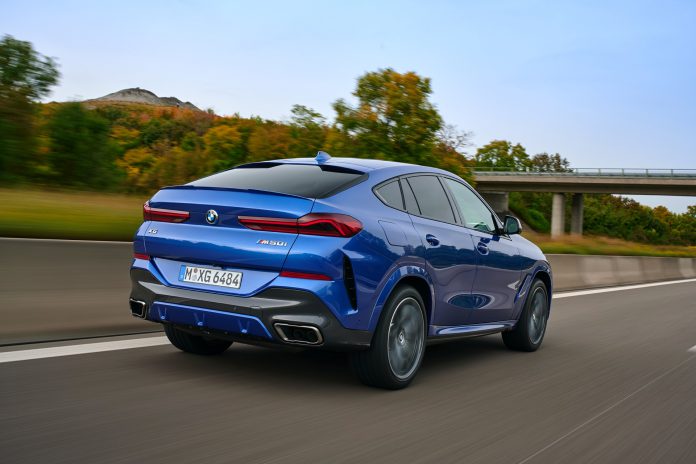BMW created a market for the mid-size luxury crossover with the original BMW X6. When it launched, back in 2008, it was the only SUV of its kind. A sleeker, sportier version of the BMW X5, it compromised boot space and practicality for a dose of sportiness. As unique as it was aesthetically challenging, the X6 divided opinions, yet sold remarkably well.
Now in its third generation, the BMW X6 has a significant amount of competition. It blazed a trail for cars like the Mercedes-Benz GLE Coupe, Range Rover Velar, Porsche Cayenne Coupe and the Audi Q8. The second generation was a simple facelift. This third-generation uses a completely new platform, shared with the recently released BMW X5.
The X6 uses BMW’s latest Cluster Architecture (CLAR) platform for the first time. It underpins cars like the 7 Series and the 5 Series, with the capacity to accept fully electric drivetrains, alongside plug-in hybrid and conventional drivetrains.
The new BMW X6 measures 26 mm longer, 15 mm wider, and 6 mm lower than the outgoing model. It uses double-wishbone front suspension and a five-link rear suspension.
Dynamic dampers are a standard feature with two settings to switch the experience from comfort to sport. An Adaptive M suspension Professional system adds active roll stabilisation and Integral Active Steering. The former attaches electric motors to the roll bars while the later adds rear-wheel steering. Other optional suspension programs include air suspension which is capable of raising or lowering the ride height by 40 millimetres.
The engine also receives some work. Those who care little for the technical details, feel free to skip a paragraph or two…
The N63 4.4 litre TwinPower Turbo V8 continues to use BMW’s xDrive all-wheel-drive combined with an M Sport electronic differential, M Sport exhaust system and model-specific suspension tuning.
In terms of the gritty detail, it is much the same as we saw in the X5 recently. BMW engineers have utilised a stronger aluminium alloy for the engine block, wire-arc sprayed iron coatings for the cylinder walls, grafal-coated pistons and a viscous damper on the crankshaft. The changes are geared towards enhancing the smooth running of the engine.
The X6 M50i puts out 530 hp and 750 Nm of torque through an eight-speed sport automatic transmission. It hits 100 km/h in 4.3 seconds and a top speed, electronically limited to 250 km/h.
On the de-restricted sections of the autobahn, we had the X6 M50i up to 250 km/h. At that speed, it felt as though the front end was beginning to lift a little. Most owners will never push these limits though. On the twisty stuff, it feels wide. It’s not a car you could confidently place into a corner without some practice! The suspension also feels hard, even with air suspension all round. We suspect this will be less obvious in more mundane models.
If the full-blooded X6 M50i is not your cup of tea, BMW offers one other petrol model and a choice of two diesels. The BMW X6 xDrive40i uses a six-cylinder 3.0-litre engine with an output of 340 hp and 450 Nm of torque. An M50d and xDrive 30d both use a six-cylinder diesel until with 400 hp and 760 Nm of torque and 265 hp and 620 Nm of torque respectively.
Of course, if the M50i isn’t quick enough for you, BMW recently announced a new X6M. If you want ultimate performance, that’s probably the one to have. That said, the X6 M50i performs well enough that you won’t feel shortchanged. In the round, it is a well rounded package with the types of compromise you expect from a vehicle of its size.
On the outside, the design looks less shocking post-4 Series revelations. The kidney grille is the dominant feature, similar in size to the X5. BMW debuts a new concept with the X6. The illuminated kidney grille. Lights shine down from the top bars of the grille, highlighting its size. Most owners will care more about the kerb appeal than anything else, the illuminated grille is clearly designed to appeal to them.
A new set of angular headlights sit either side with a sharper front bumper. A new set of front and rear fender vents lead to broad-shouldered wheel arches. At the rear, the hatch looks similar to that of the X4. The bootlid spoiler has become an M car characteristic of late.
All in, the X6 is an evolution rather than revolution. If you liked the outgoing version then you are likely to love the updates.
Inside, the changes are similar to those found in the new X5. The dash display is fully digital. Our test model had a head-up display and the centre console featuring a large 12.3-inch display. The combination of BMW’s Operating System 7.0 and Live Cockpit Professional brings the X6 bang up to date. The system allows for remote software updates too.
The X6 was always criticised as having cramped rear seats. While the exterior proportions have grown, the interior remains cramped somewhat. Rear passengers gain a small amount of additional space, although we didn’t spend a great deal of time exploring whether the new design makes a practical difference.
An interesting feature is the BMW Display Key. Due to the short amount of time we had with the X6, it wasn’t possible to get to the bottom of its features. However, it works like a smartphone, using Near Field Communication and an integrated display to offer options that a conventional key simply will not.
From a pragmatic point of view, the X6 shouldn’t work. It is an unholy compromise between the practicality of an SUV and the sporting prowess of a coupe. That said, the demand for luxury crossover SUV’s is strong at the moment, with plenty of competition. BMW has seen huge success with previous generations of X6 and this latest version is likely to appeal to its established customer base. If it is what the people want, who are we to complain?



